Related Research Articles

A riad or riyad is a type of garden courtyard historically associated with house and palace architecture in the Maghreb and al-Andalus. Its classic form is a rectangular garden divided into four quadrants by two paved paths intersecting in the center, where a fountain is typically situated. The planted areas are usually sunken below the level of the paths. Its origin is generally attributed to traditional Persian gardens whose influence spread during the Islamic period. The term "riad" is nowadays often used in Morocco to refer to a hotel or guesthouse-style accommodation with shared common areas and private rooms, often within a restored traditional mansion.

Moroccan architecture reflects Morocco's diverse geography and long history, marked by successive waves of settlers through both migration and military conquest. This architectural heritage includes ancient Roman sites, historic Islamic architecture, local vernacular architecture, 20th-century French colonial architecture, and modern architecture.

The Chellah or Shalla, is a medieval fortified Muslim necropolis and ancient archeological site in Rabat, Morocco, located on the south (left) side of the Bou Regreg estuary. The earliest evidence of the site's occupation suggests that the Phoenicians established a trading emporium here in the first millennium BC. This was later the site of Sala Colonia, an ancient Roman colony in the province of Mauretania Tingitana, before it was abandoned in Late Antiquity. In the late 13th century the site began to be used as a dynastic necropolis for the Marinid dynasty. By the mid-14th century Marinid sultans had enclosed a part of the site with a new set of walls and built a religious complex inside it to accompany their mausoleums. In the 15th century the necropolis began to decline and it suffered damage over the centuries due to earthquakes and looting. Archeological excavations in the 20th century unearthed the remains of the ancient Roman town. Today the site is a tourist attraction and since 2012 it forms part of a UNESCO World Heritage Site.

The Museum of Marrakech is a historic palace and museum located in the old center of Marrakesh, Morocco. In addition to its notable architecture, the museum's collection showcases various historic art objects and contemporary art from Morocco.

Moorish architecture is a style within Islamic architecture which developed in the western Islamic world, including al-Andalus and what is now Morocco, Algeria, and Tunisia. Scholarly references on Islamic architecture often refer to this architectural tradition in terms such as architecture of the Islamic West or architecture of the Western Islamic lands. The use of the term "Moorish" comes from the historical Western European designation of the Muslim inhabitants of these regions as "Moors". Some references on Islamic art and architecture consider this term to be outdated or contested.

The Bou Inania Madrasa or Bu 'Inaniya Madrasa is a madrasa in Fes, Morocco, built in 1350–55 CE by Abu Inan Faris. It is the only madrasa in Morocco which also functioned as a congregational mosque. It is widely acknowledged as a high point of Marinid architecture and of historic Moroccan architecture generally.

Funduq al-Najjarin is a historic funduq in Fes el Bali, the old medina quarter in the city of Fez, Morocco.

Sahrij Madrasa or Madrasa al-Sahrij is a madrasa in Fez, Morocco. The madrasa is located inside Fes el Bali, the old medina quarter of the city. The madrasa dates back to the 14th century during the golden age of Fez under Marinid rule. The madrasa is located near Al Andalus Mosque and is also connected to another, smaller, madrasa built at the same time, the Sba'iyyin Madrasa.

The architecture of Fez, Morocco, reflects the wider trends of Moroccan architecture dating from the city's foundation in the late 8th century and up to modern times. The old city (medina) of Fes, consisting of Fes el-Bali and Fes el-Jdid, is notable for being an exceptionally well-preserved medieval North African city and is classified as a UNESCO World Heritage Site. A large number of historic monuments from different periods still exist in it today, including mosques, madrasas, synagogues, hammams (bathhouses), souqs (markets), funduqs (caravanserais), defensive walls, city gates, historic houses, and palaces.
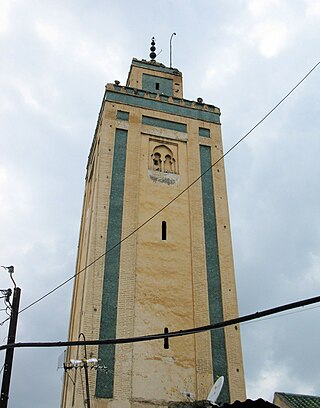
The Moulay Abdallah Mosque or Mosque of Moulay Abdallah is a major mosque and royal necropolis complex situated in the center of the Moulay Abdallah district in Fes el-Jdid, the historic palace-city and citadel in Fes, Morocco. It was founded by the Alaouite sultan Moulay Abdallah who is buried in the adjoining necropolis along with later members of the dynasty.

The Lalla ez-Zhar Mosque, or al-Zahr Mosque, is a mosque located in Fes el-Jdid in the historic old city of Fez, Morocco. It is also known by the name Jama’ el-Hajjar, probably in reference to its stone portal entrance. The mosque was founded or completed in 1357 CE by the Marinid sultan Abu Inan.
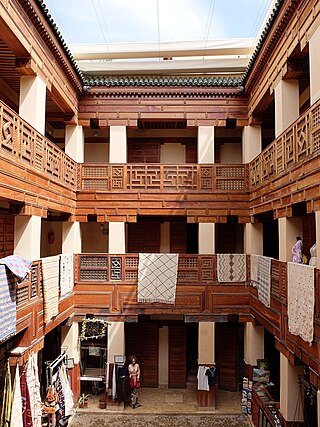
The Funduq al-Tetwaniyyin, also known as the Funduq al-Staouniyine, is a historic funduq (caravanserai) in Fes el-Bali, the old city of Fes, Morocco.
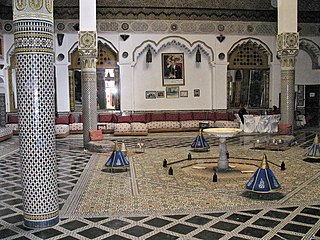
The Mnebhi Palace or Menebhi Palace, also known by its French name Palais Mnebhi, is a historic early 20th-century palace in Fes el-Bali, the old medina of Fes, Morocco. It is notable for both its lavish architecture as well as for being the place where the 1912 Treaty of Fes was officially signed. It is located on Tala'a Seghira street, one of the main souq streets of the city.

Funduq Sagha is a historic funduq in Fes el Bali, the old medina quarter in the city of Fez, Morocco.
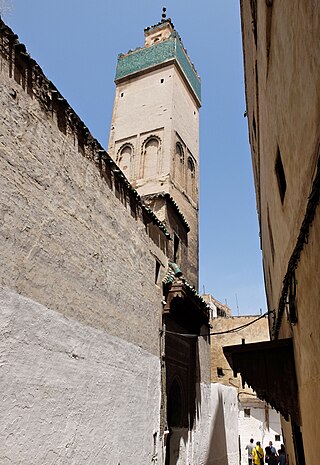
The Zawiya of Sidi Taoudi Ben Souda is a zawiya and mosque in Fes el-Bali, the old medina of Fes, Morocco. It is named after Muḥammad al-Tāwdī Ibn al-Ṭālib Ibn Sūda al-Murrī, an 18th-century Sufi sheikh who is considered by some to be one of the foremost intellectuals and Muslim scholars of Morocco's history.
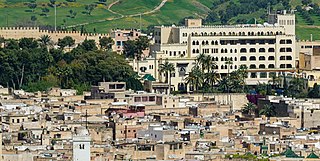
The Jamai Palace, also known as the Dar Jama'i or the Palais Jamaï, is a historic late 19th-century mansion near Bab Guissa in Fes el-Bali in Fes, Morocco. It was converted to a luxury hotel in 1919, which closed in 2014.
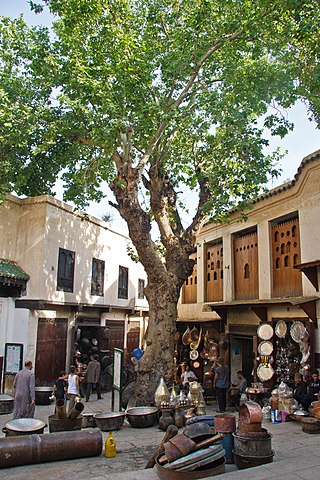
Place Seffarine or Seffarine Square is a small square in the medina of Fes, Morocco. It is located on the south side of the Qarawiyyin Mosque, close to the Bou Khrareb River which runs through the heart of the medina. The square dates back to the Middle Ages but has also undergone renovations in modern times. It is adjoined by the Qarawiyyin's library to the northwest, by the Saffarin Madrasa to the east, and by the Saffarin Hammam (bathhouse) to the southwest. It is named after the coppersmiths who have had their workshops here for centuries.

The Hammam as-Saffarin is a historic hammam (bathhouse) in the medina of Fes, Morocco. It is located on the southwest side of Place Seffarine, across from the Madrasa Saffarin and south of the Qarawiyyin Mosque.
Hammam Ben Abbad or Hammam Ibn Abbad is a historic hammam (bathhouse) in the medina of Fes, Morocco. It is located in the Kettanin neighbourhood south of the Zawiya of Moulay Idris, near the Funduq Kettanin. The hammam dates from the 14th century and was recently restored during a major rehabilitation program involving over two dozen other historic monuments in the city. Its name comes from a local Muslim saint who is associated with the building, and the waters of the hammam were believed to have healing properties. Entered from the north, the hammam has the usual series of rooms inherited from the Roman bathhouse model: an undressing room, a cold room (frigidarium), warm room (tepidarium), and a hot room (calderium). The hammam was part of the habous (endowment) of the Qarawiyyin Mosque.
References
- ↑ Raftani, Kamal; Radoine, Hassan (2008). "The Architecture of the Hammams of Fez, Morocco". Archnet-IJAR. 2 (3): 56–68.
- ↑ Sibley, Magda; Jackson, Iain (2012). "The architecture of Islamic public baths of North Africa and the Middle East: an analysis of their internal spatial configurations". Architectural Research Quarterly. 16 (2): 155–170. doi:10.1017/S1359135512000462.
- 1 2 Terrasse, Henri (1950). "Trois Bains Mérinides du Maroc". Mélanges offerts à William Marçais par l'Institut d'études islamiques de l'Université de Paris. Paris: Éditions G.-P. Maisonneuve.
- ↑ Le Tourneau, Roger (1949). Fès avant le protectorat: étude économique et sociale d'une ville de l'occident musulman. Casablanca: Société Marocaine de Librairie et d'Édition.
- ↑ Fournier, Caroline (2016). "Chapitre V: Différents modèles de ḥammāms en al-Andalus". Les Bains d'al-Andalus: VIIIe-XVe siècle. Rennes: Presses universitaires de Rennes.
- ↑ Secret, Edm. (1942). "Les hammams de Fes" (PDF). Bulletin de l'Institut d'Hygiène du Maroc. 2: 61–78.
34°03′37.8″N4°58′18.6″W / 34.060500°N 4.971833°W